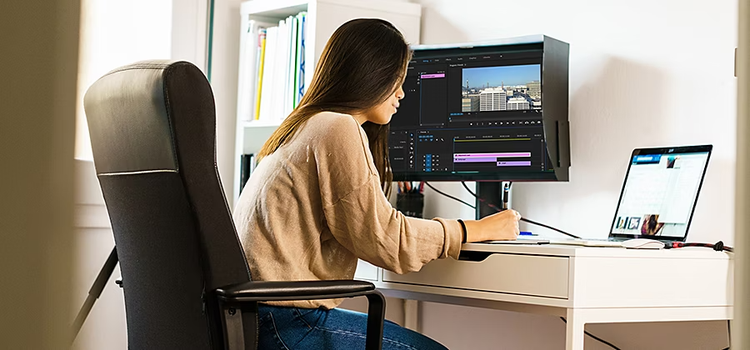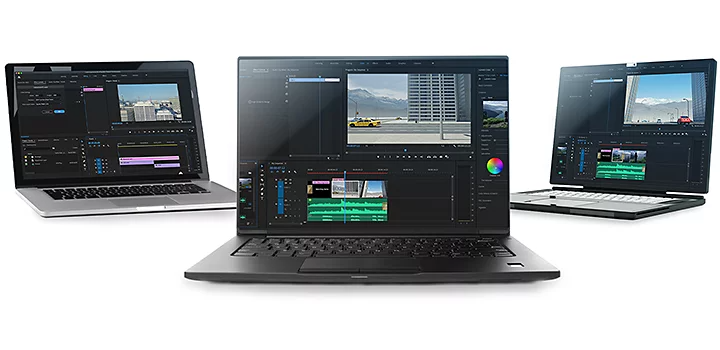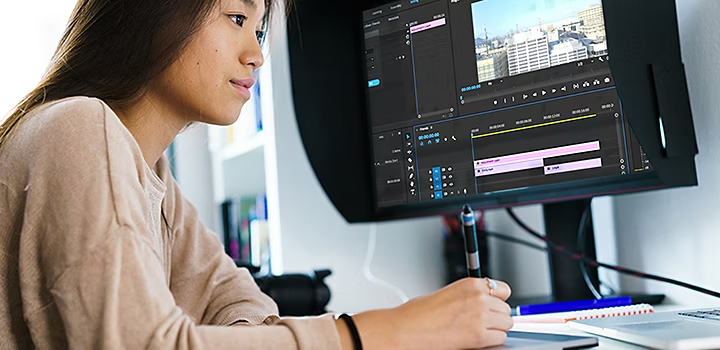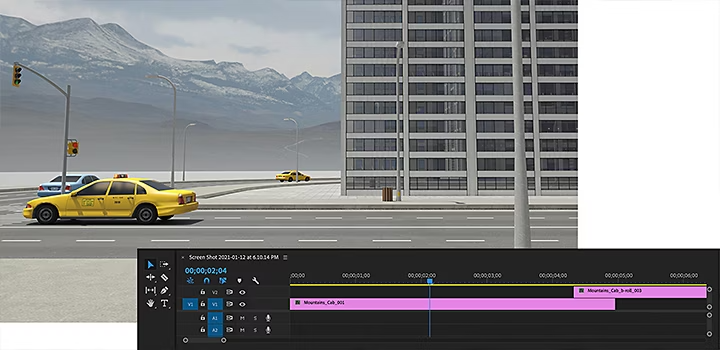video
How to find the best laptops for video editing.
From storage and memory to graphics cards and processors, discover what really matters when it comes to purchasing a video editing laptop.

What professional video editors look for in a laptop.
Videographers spend just as much, if not more, time behind their computer as they do their cameras. And many creatives value the portability that laptops offer. However, the laptop you use for browsing the internet might not be able to quickly or smoothly process the large amount of data in video files, especially in high-resolution clips.
Investing in a powerful laptop is key, whether video editing is a passion project or the way you pay your bills.
The minimum requirements
If you plan to edit your videos with Adobe Premiere Pro, the minimum requirement is that your machine support a compatible operating system.
For Apple computers at this time, that’s macOS X 10.9 or later. For PCs, it’s Windows 7 or later, although your best bet is to always update to the newest operating system possible for your device. For PCs in 2021, the latest is Windows 10. And for Apple laptops, it’s macOS X 11.1.

Popular video editing laptops
In addition to the right operating system, you’ll need a laptop with components strong enough to manage video files with high bitrates (the amount of data in your video) and frame rates (the number of frames per second). Luckily, there are many high-end machines that are up to the task.
As you research the best laptops for imagery and video work, you’ll see certain brand names popping up often. Here is a small sampling of laptop models used for video work:
- For community seekers: The Apple MacBook Pro gives you access to the Apple ecosystem.
- For versatile workers: The Microsoft Surface Book is a tablet and laptop in one.
- For extreme-climate dwellers: The Lenovo ThinkPad X1 Extreme can take heat and humidity.
- For light packers: The Dell XPS 15 boasts a light weight and vivid colors.
- For the adventurous: The MSI WS65 9TM features military-grade durability.
- For the color-obsessed: The Acer ConceptD 3 Pro offers Pantone-validated color accuracy.
- For the multitasker: The Asus ZenBook Pro has a dual touchscreen.
- For the gamer/editor: The Razer Blade 15 has both gaming and video editing capabilities.
The building blocks of a great video editing laptop.
The right laptop for video editing is less about brand name or storage space and more about the right components for your workflow.
“For video editing, the number one thing you have to look at is your processor and your graphics card. Then your RAM, or your memory,” says videographer Chris Printz. “When I buy a new laptop, I don’t care as much about the storage. That’s because I don’t edit from my desktop. All my footage that I’m editing is going to be on an external SSD.”
Storage
“Storage isn’t that important because you’re probably editing all on external hard drives,” seconds videographer Joshua Flom. “I would say get a minimum of 1TB SSD, just so you can have proxy files or render files on your actual device.”
SSD stands for solid-state drive, a newer and faster version of a hard disk drive (HDD). If budget is a concern, a 512GB SSD might even be enough in terms of internal storage since external SSD storage is an affordable and easy way to enhance your laptop’s performance.
If you dig a little deeper on SSDs, you’ll likely run into the acronyms PCIe and NVMe: good news if you’ll be handling more intense projects. These terms represent the latest interface and protocol for managing the data on your SSD quickly, and most high-end workstations, such as the Apple MacBook Pro, already use them.

Memory (RAM)
“Memory is a very important piece when it comes to video editing. I would say get a minimum of 32GB of RAM. But if you can get 64 gigs, that’s bonus points,” says Flom. “If you’re going to be editing anything 4K, 32 is the lowest you want to go. I have 64, and I wish I had more.”
The buzzword you’re likely to run into when researching RAM (which stands for random-access memory) is DDR4. This is the latest configuration of memory, and it gives your device a higher bandwidth than its predecessors (DDR3 and prior). Most high-quality laptops released in the past two years feature DDR4 RAM, including those from Dell, Asus, Apple, HP, and more.

Processor (CPU)
Your processor or CPU might be described as the heart of your laptop. And investing in the most advanced CPU you can means your computer will stay sharper longer. “Obviously you need a strong processor,” says Flom. “Max that out.”
Your CPU chip contains a certain number of cores with which it processes instructions, and the speed at which it processes is measured in GHz (gigahertz). More cores means faster processing: a quad-core (common in many of today’s premium workstations) is faster than a dual-core, and so on.
Intel’s core processors are common in many popular brands of laptops, with 10th-generation Intel processors at the forefront of advancement in 2021. The Intel Core i5 processor and the Intel Core i7 processor provide sufficient performance for creative tasks, and the even faster Intel Core i9 processor powers the MacBook Pro.
Many premium Intel processors nowadays include a Turbo Boost feature. This allows the processor to run at lower speeds to conserve energy when possible and then boost up to higher speeds only when faster performance is needed.
Graphics card (GPU)
Another item you’ll find in the best laptops for video editing is a dedicated graphics card, or GPU. Some more affordable computers process graphics using a graphics card that’s integrated with the CPU, while more powerful laptops used for gaming or project creation often boast a separate GPU with its own memory for powerful imagery processing (VRAM, or video random access memory). If you can, aim for four to eight gigabytes of dedicated VRAM.
“The biggest piece people always forget about is the graphics card,” says Flom. “They think that if you shove a computer full of memory, you’re good to go. But your graphics card is processing all the images, creating the proxy files, everything else. Boost up that graphics card.”
Chances are, if you want to invest in a high-quality machine, part of what you’ll pay extra for is a strong graphics card. But if you work on a laptop without a dedicated GPU, you can purchase an external GPU (eGPU) and plug it into your Thunderbolt 3 or USB-C port.
Nvidia is known for its line of gaming laptops, which use the company’s trademarked Max-Q technology to fit a lot of power into a small machine. The company also creates the advanced graphics cards inside several laptops made for video editing and design by companies like Asus, Acer, Dell, and Microsoft. Some examples include the Nvidia GeForce GTX and Nvidia Quadro RTX. The AMD Radeon Pro is another GPU featured in high-powered machines, such as the MacBook Pro.

Displays, monitors, and all the trimmings.
Screen quality is crucial in video editing. If you edit high-resolution (HD) video footage that viewers will watch on HD devices, you need to make sure you see an accurate depiction of the footage on your screen as you edit, including crisp imagery and color accuracy.
Most laptop screens are LCD screens that use the RGB (backlit red, green, and blue hue) system to display their color gamut, or the full array of colors they can successfully mimic. The brightness of your display is measured in nits, and the definition is measured by the number of pixels contained in one column of the screen.
A high-quality display on your laptop is important, but the size of it matters less. Because you’ll likely plug into a larger external monitor for editing work, shelling out extra money for a bigger screen on your laptop isn’t wise.
High-definition monitors
Many cheaper monitors display at full HD (FHD) or less (meaning they display 1080 pixels per column), which can be just fine for a secondary monitor. However, a UHD (Ultra High-Definition) display, as found on many premium laptops, offers crisper video resolution and is a good tool for video editors.
UHD is the equivalent of roughly 4,000 pixels in a column and is sometimes referred to as 4K UHD. Slightly more high-definition than 4K, Apple’s trademarked Retina display is named for the fact that it claims to make pixels undetectable to the human eye.
If you’re looking for an HD monitor with a bright display that can be seen from all angles, a 4K OLED display will do the trick. OLED technology is an advanced way to light up vibrant colors and keep images vivid, even when you’re standing to the side of the screen.
A more affordable way to increase your viewing angles than an OLED screen is to look for an LED monitor with IPS (in-plane switching) screen technology. The liquid crystals used in an IPS LCD monitor can shift horizontally, which helps increase the screen’s color accuracy when viewed from an angle.
Connectivity, battery life, and add-ons
If you plan to invest in a high-end laptop, the ability to connect to Wi-Fi networks and Bluetooth devices should never pose a problem. Battery life, however, does vary between premium machines and should be considered. This can range anywhere from eight hours to nearly 20.
Don’t let little odds and ends sway your purchase. If you require more ports for HDMI or USB cords, a memory card reader, or other extras like external webcams, you can purchase these items easily from Amazon and other major retailers and then simply plug them into your laptop.

Edit like a pro on any compatible laptop.
Once you know what components are important for video editing, it’s clear there isn’t just one best video editing laptop but instead many ways to get the bang you need for your buck. And with a computer that runs smoothly, you’re free to do amazing things with video editing software like Adobe Premiere Pro.
While a high-end camera is a fantastic tool, it isn’t the end of the story when it comes to photography and videography. “When you think about cameras, we could be spending $10,000,” says Flom. “But in reality, the laptop is 75 percent of what we’re using. So throw some more dollars in your computer, and you’re going to be thankful you did.”
Equip yourself with all the right tools, and you can edit videos to your heart’s content.
